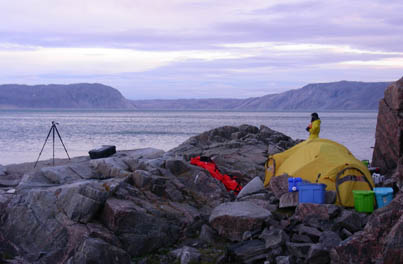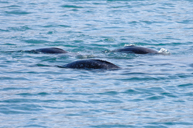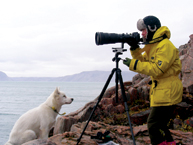Finding narwhals

Narwhal researchers Marianne Marcoux and Marie Auger-Méthé called this tent home for three weeks. For more photos see http://whitelab.biology.dal.ca/mm/project.html.
How one McGill student spent her summer holiday
Photos by Marie Auger-Méthé
How did Marianne Marcoux spend her summer vacation? Perched high above the chilly Arctic waters of Baffin Island in a parka.
The Natural Resource Sciences doctoral student spent three weeks on rocky cliffs on the northern tip of the island in Nunavut, drawn by the beauty of the sparse Arctic landscape and the mysteries of the unicorn of the sea. Marcoux is researching the social structure of narwhals, gray five-metre-long whales that inhabit the cold North Atlantic Ocean. The males have two-metre spiraled tusks from which they get their unicorn nickname. Though scientists talk confidently of most whale species, little is known about narwhals, which number up to 30,000.

A cluster of three narwhals, taken with a camera on generous loan from Nikon.
The first step toward demystifying the beasts is to ID them. From a bayside vantage point, Marcoux's colleague, Marie Auger-Méthé from Dalhousie University, took 2,000 photos while Marcoux took notes on roughly 1,000 clusters of narwhals. "It is really impressive to observe hundreds of narwhals coming into the bay at the same time. When the bay was really calm, we could hear them breathing, or blowing, and it felt like they were really close to us," she said.
While killer whales have easily identifiable markings and dorsal fins, narwhals have only a dorsal ridge. And because they don't often fluke — that is lift their tail as they dive down — observers are limited to the mottled pattern and visible scars on a narwhal's back.

A furry pal watches Marcoux take a turn at the camera.
By getting baseline information on the structure and size of groups, and returning each year, Marcoux may be able to tell if narwhals mate for more than one season, or form cliques and friendships.
People in other locations will be able to ID narwhals using Marcoux and Auger-Méthé's photo catalogue, helping Marcoux calculate their movement and migration. She also made underwater recordings of their sounds, so she can eventually relate their behaviour to vocalization. Like all toothed whales, they use echolocation to make clicks, along with whistles. But overall, Marcoux said, "they sound like sheep."
To prepare for Arctic research, they had to coordinate with the nearby community of Pond Inlet, get gun permits, hire a guide for bear protection and lug up as much dehydrated foodstuffs as they could carry. Since there was no electricity to recharge camera or laptop batteries, they brought plenty of backup technology.
Though warm by Arctic standards —10 degrees in the day — the two would bundle up in parkas and fur hats, to the amusement of the locals. "Sometimes we'd dance to keep warm," Marcoux laughed.
Despite the rigours, summertime is relatively easy, thanks to the season's temperature and daylong light. Unfortunately, few scientists have observed narwhals where they winter, in Davis Strait, some 1,000 km away. "I have a crazy dream of using a night vision goggle in winter," said Marcoux. "Maybe if I become a millionaire."

A unicorn of the sea lifts his tusk high.

